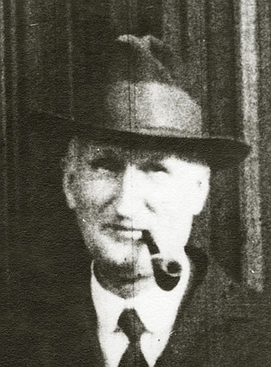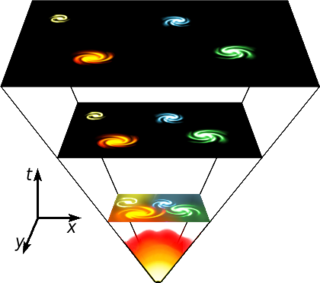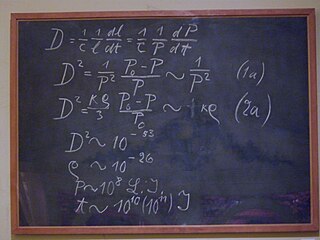Related Research Articles

Physical cosmology is a branch of cosmology concerned with the study of cosmological models. A cosmological model, or simply cosmology, provides a description of the largest-scale structures and dynamics of the universe and allows study of fundamental questions about its origin, structure, evolution, and ultimate fate. Cosmology as a science originated with the Copernican principle, which implies that celestial bodies obey identical physical laws to those on Earth, and Newtonian mechanics, which first allowed those physical laws to be understood.

In cosmology, the cosmological constant, alternatively called Einstein's cosmological constant, is the constant coefficient of a term that Albert Einstein temporarily added to his field equations of general relativity. He later removed it. Much later it was revived and reinterpreted as the energy density of space, or vacuum energy, that arises in quantum mechanics. It is closely associated with the concept of dark energy.
The following is a timeline of gravitational physics and general relativity.

The Big Crunch is a hypothetical scenario for the ultimate fate of the universe, in which the expansion of the universe eventually reverses and the universe recollapses, ultimately causing the cosmic scale factor to reach zero, an event potentially followed by a reformation of the universe starting with another Big Bang. The vast majority of evidence indicates that this hypothesis is not correct. Instead, astronomical observations show that the expansion of the universe is accelerating rather than being slowed by gravity, suggesting that a Big Freeze is more likely. However, there are new theories that suggest that a "Big Crunch-style" event could happen by the way of a dark energy fluctuation; however, this is still being debated amongst scientists.
A non-standard cosmology is any physical cosmological model of the universe that was, or still is, proposed as an alternative to the then-current standard model of cosmology. The term non-standard is applied to any theory that does not conform to the scientific consensus. Because the term depends on the prevailing consensus, the meaning of the term changes over time. For example, hot dark matter would not have been considered non-standard in 1990, but would be in 2010. Conversely, a non-zero cosmological constant resulting in an accelerating universe would have been considered non-standard in 1990, but is part of the standard cosmology in 2010.

Georges Henri Joseph Édouard Lemaître was a Belgian Catholic priest, theoretical physicist, mathematician, astronomer, and professor of physics at the Catholic University of Louvain. He was the first to theorize that the recession of nearby galaxies can be explained by an expanding universe, which was observationally confirmed soon afterwards by Edwin Hubble. He first derived "Hubble's law", now called the Hubble–Lemaître law by the IAU, and published the first estimation of the Hubble constant in 1927, two years before Hubble's article. Lemaître also proposed the "Big Bang theory" of the origin of the universe, calling it the "hypothesis of the primeval atom", and later calling it "the beginning of the world".
A de Sitter universe is a cosmological solution to the Einstein field equations of general relativity, named after Willem de Sitter. It models the universe as spatially flat and neglects ordinary matter, so the dynamics of the universe are dominated by the cosmological constant, thought to correspond to dark energy in our universe or the inflaton field in the early universe. According to the models of inflation and current observations of the accelerating universe, the concordance models of physical cosmology are converging on a consistent model where our universe was best described as a de Sitter universe at about a time seconds after the fiducial Big Bang singularity, and far into the future.
In physical cosmology, the age of the universe is the time elapsed since the Big Bang. Astronomers have derived two different measurements of the age of the universe: a measurement based on direct observations of an early state of the universe, which indicate an age of 13.787±0.020 billion years as interpreted with the Lambda-CDM concordance model as of 2021; and a measurement based on the observations of the local, modern universe, which suggest a younger age. The uncertainty of the first kind of measurement has been narrowed down to 20 million years, based on a number of studies that all show similar figures for the age. These studies include researches of the microwave background radiation by the Planck spacecraft, the Wilkinson Microwave Anisotropy Probe and other space probes. Measurements of the cosmic background radiation give the cooling time of the universe since the Big Bang, and measurements of the expansion rate of the universe can be used to calculate its approximate age by extrapolating backwards in time. The range of the estimate is also within the range of the estimate for the oldest observed star in the universe.

In general relativity, Birkhoff's theorem states that any spherically symmetric solution of the vacuum field equations must be static and asymptotically flat. This means that the exterior solution must be given by the Schwarzschild metric. The converse of the theorem is true and is called Israel's theorem. The converse is not true in Newtonian gravity.
General relativity is a theory of gravitation that was developed by Albert Einstein between 1907 and 1915, with contributions by many others after 1915. According to general relativity, the observed gravitational attraction between masses results from the warping of space and time by those masses.

William Duncan MacMillan was an American mathematician and astronomer on the faculty of the University of Chicago. He published research on the applications of classical mechanics to astronomy, and is noted for pioneering speculations on physical cosmology. For the latter, Helge Kragh noted, "the cosmological model proposed by MacMillan was designed to lend support to a cosmic optimism, which he felt was threatened by the world view of modern physics."

The history of the Big Bang theory began with the Big Bang's development from observations and theoretical considerations. Much of the theoretical work in cosmology now involves extensions and refinements to the basic Big Bang model. The theory itself was originally formalised by Father Georges Lemaître in 1927. Hubble's Law of the expansion of the universe provided foundational support for the theory.
In cosmology, a static universe is a cosmological model in which the universe is both spatially and temporally infinite, and space is neither expanding nor contracting. Such a universe does not have so-called spatial curvature; that is to say that it is 'flat' or Euclidean. A static infinite universe was first proposed by English astronomer Thomas Digges (1546–1595).
In physical cosmology and astronomy, dark energy is an unknown form of energy that affects the universe on the largest scales. Its primary effect is to drive the accelerating expansion of the universe. Assuming that the lambda-CDM model of cosmology is correct, dark energy is the dominant component of the universe, contributing 68% of the total energy in the present-day observable universe while dark matter and ordinary (baryonic) matter contribute 26% and 5%, respectively, and other components such as neutrinos and photons are nearly negligible. Dark energy's density is very low: 6×10−10 J/m3, much less than the density of ordinary matter or dark matter within galaxies. However, it dominates the universe's mass–energy content because it is uniform across space.
The Einstein–de Sitter universe is a model of the universe proposed by Albert Einstein and Willem de Sitter in 1932. On first learning of Edwin Hubble's discovery of a linear relation between the redshift of the galaxies and their distance, Einstein set the cosmological constant to zero in the Friedmann equations, resulting in a model of the expanding universe known as the Friedmann–Einstein universe. In 1932, Einstein and De Sitter proposed an even simpler cosmic model by assuming a vanishing spatial curvature as well as a vanishing cosmological constant. In modern parlance, the Einstein–de Sitter universe can be described as a cosmological model for a flat matter-only Friedmann–Lemaître–Robertson–Walker metric (FLRW) universe.
Albert Einstein conducted several unsuccessful investigations. These pertain to quantum mechanics, superconductivity, and his details on his own theory of relativity.

Einstein's Blackboard is a blackboard which physicist Albert Einstein (1879–1955) used on 16 May 1931 during his lectures while visiting the University of Oxford in England. The blackboard is in the collection of the Museum of the History of Science in Oxford. The equations in the blackboard are related to the cosmological model known as Friedmann–Einstein universe.

Cormac O'Raifeartaigh is an Irish physicist based at Waterford Institute of Technology in Ireland. A solid-state physicist by training, he is best known for several contributions to the study of the history and philosophy of 20th century science, including the discovery that Albert Einstein once attempted a steady-state model of the expanding universe, many years before Fred Hoyle.
The Friedmann–Einstein universe is a model of the universe published by Albert Einstein in 1931. The model is of historic significance as the first scientific publication in which Einstein embraced the possibility of a cosmos of time-varying radius.
In cosmology, Gurzadyan theorem, proved by Vahe Gurzadyan, states the most general functional form for the force satisfying the condition of identity of the gravity of the sphere and of a point mass located in the sphere's center. This theorem thus refers to the first statement of Isaac Newton’s shell theorem but not the second one, namely, the absence of gravitational force inside a shell.
References
- ↑ Einstein, Albert (1917). "Kosmologische Betrachtungen zur allgemeinen Relativitätstheorie" [Cosmological considerations on the general theory of relativity]. Sitzungs. König. Preuss. Akad. (in German): Sitzungsb. König. Preuss. Akad. 142–152.
- ↑ Lorentz H.A.; Einstein A.; Minkowski H.; H. Weyl (1923). The Principle of Relativity. New York: Metheun & Co. pp. 175–188.
- ↑ O'Raifeartaigh; et al. (2017). "Einstein's 1917 static model of the universe: a centennial review". Eur. Phys. J. H. 42 (3): 431–474. arXiv: 1701.07261 . Bibcode:2017EPJH...42..431O. doi:10.1140/epjh/e2017-80002-5. S2CID 119461771.
- ↑ Hubble, Edwin (1929). "A relation between distance and radial velocity among extra-galactic nebulae". Proceedings of the National Academy of Sciences. 15 (3): 168–173. Bibcode:1929PNAS...15..168H. doi: 10.1073/pnas.15.3.168 . PMC 522427 . PMID 16577160.
- ↑ Einstein, Albert (1931). "Zum kosmologischen Problem der allgemeinen Relativitätstheorie". Sitzungsb. König. Preuss. Akad.: 235–237.
- ↑ Einstein, Albert (1946). Relativity: The Special and General Theories (16th ed.). New York: Metheun. p. 137.
- ↑ O'Raifeartaigh and McCann (2014). "Einstein's cosmic model of 1931 revisited: an analysis and translation of a forgotten model of the universe". Eur. Phys. J. H. 39 (1): 63–85. arXiv: 1312.2192 . Bibcode:2014EPJH...39...63O. doi:10.1140/epjh/e2013-40038-x. S2CID 53419239.
- ↑ Nussbaumer and Bieri (2009). Discovering the Expanding Universe. Cambridge: Cambridge University Press. p. 147.
- ↑ A. S. Eddington (9 May 1930). "On the Instability of Einstein's Spherical World". Monthly Notices of the Royal Astronomical Society. 90 (7): 668–678. doi: 10.1093/mnras/90.7.668 .
- ↑ Zimmer, Carl (9 June 2013). "The Genius of Getting It Wrong: Brilliant Blunders by Mario Livio". The New York Times . Archived from the original on 18 June 2013.